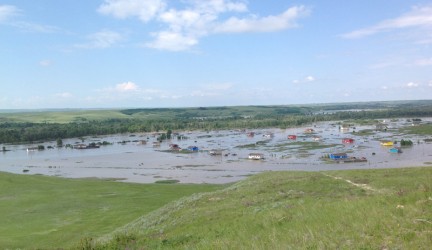Article Origin
Volume
Issue
Year
Rain-swollen rivers and torrential downpours forced the evacuation of close to 2,000 First Nations members in southern Alberta and resulted in the Siksika Nation, Tsuu T’ina Nation and Stoney Nakoda Nations declaring states of local emergency on June 20.
A week later with close to 1,000 people still displaced, the First Nations were experiencing numerous infrastructure issues including washed out roads, restricted bridge-use, boil water advisories, and concerns over power and telephone land lines. Members also needed to be fed and supplied with personal items and clothes. Alberta Emergency Management Agency field officers remained in Siksika and Morley to provide assistance and advice.
“It is the worst natural disaster I have seen affecting Nation members,” said Siksika Chief Fred Rabbit Carrier. “The emotion of helplessness, stress is associated with any kind of natural disaster.”
Approximately 1,000 residents, one-quarter of on-reserve members, were forced to evacuate their homes on the Siksika First Nation as the Bow River overflowed. An evacuation centre was established at the Deerfoot Sportsplex. The structural damage to two bridges cut the reserve in half, turning a 10 to 20-minute trip to cross the reserve into one to two hours. Over 200 residences were under water.
The Hidden Valley Golf Resort, with about 300 cabins and a nine-hole golf course, was also engulfed.
Dave Galea, executive director, public safety initiatives with AEMA, said resources will be provided to Siksika, “which suffered significant damage,” as the needs are identified.
Close to 700 members of Stoney Nakoda Nations in Eden Valley, Bighorn and Morley were evacuated.
No assistance was requested for Bighorn, said Galea, but provincial government assistance is being provided in Morley and Eden Valley.
Fifty people were evacuated for two days at Tsuu T’ina from the townsite and near the golf course. Two families had to be air-lifted by helicopter and were not allowed to return to their homes.
“Our infrastructure is pretty good and every part of the reserve is accessible now,” said Lee Crowchild, Tsuu T’ina director of emergency management.
Neither Kainai nor Piikani First Nations declared states of local emergency, said Galea.
Forty people along a 10-mile stretch that borders the Old Man River were evacuated as a precautionary measure, says Oscar Cotton, disaster coordinator for the Kainai reserve.
“We were on high alert for several days, but we were really fortunate,” said Cotton. “Other floods in the past it felt as if we took the brunt of them. We feel for everybody else because we know what that’s like.”
A small number of residents were evacuated on the Piikani First Nation and others put on alert.
Premier Alison Redford declared the flooding the worst in Alberta history and set up a $1 billion fund as part of the first phase of emergency recovery and reconstruction; established the Southern Alberta Ministerial Task Force, which includes Aboriginal Relations Minister Robin Campbell; and appointed three associate ministers to do work on the ground.
Redford’s package includes pre-loaded debit cards of $1,250 per adult and $500 per child for those out-of-home for more than one week. First Nations members will receive those debit cards.
“My task is to rebuild the First Nations,” said Campbell, who toured flood sites and met with Chiefs and councils, and Assembly of First Nations National Chief Shawn Atleo. Atleo was in Calgary and Lethbridge when the flooding began. He returned June 26 and 27 to meet with impacted leadership as well as provincial and federal politicians.
“I’ve been very impressed with how quickly Alberta (government) has stepped up,” said Rabbit Carrier.
“Our main concern is that we have people who are vulnerable and in need and we’re just going to make sure they’re looked after,” said Campbell. “We’re not worrying about the payment….We’ll have to sit down with the feds and have that discussion.”
Aboriginal Affairs and Northern Development Canada Minister Bernard Valcourt met with Siksika First Nation on June 27. Valcourt was accompanied by federal ministers Ted Menzies (finance), Vic Toews (public safety) and Jason Kenney (southern Alberta). Officials from Valcourt’s department as well as Health Canada had been on-site already.
“I committed … that our government will continue working closely with First Nations in Alberta and with the province to ensure a full recovery in as timely a manner as possible,” said Valcourt in a statement.
No dollar figure has been given to the damage but it is expected it will take years for parts of the impacted reserves to be restored.
“There’s a lot of work to be done,” said Campbell.
Over 25 municipalities declared states of emergency, including the City of Calgary, which evacuated 85,000 people, and the town of High River, which saw all 13,000 residents forced to flee.
- 6685 views

